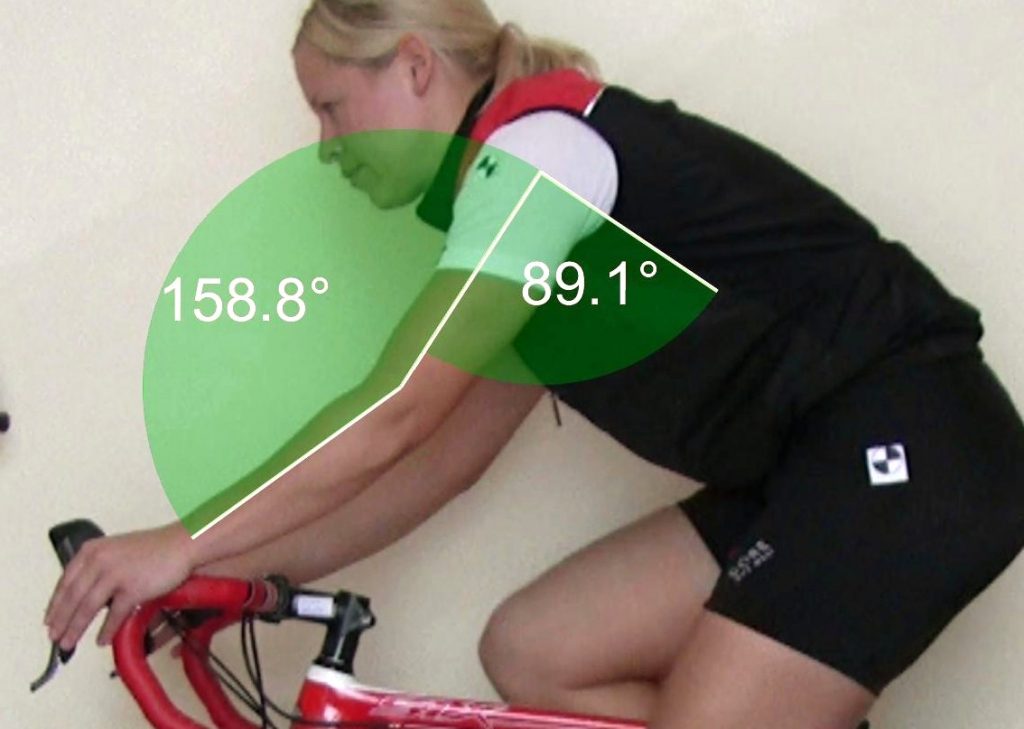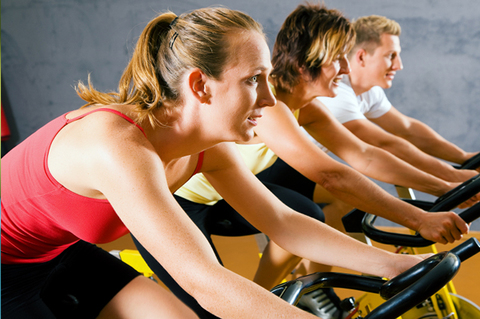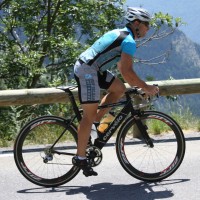Regarding the 3-2-1 Interval profile, ICA member Lynn asked about where to put the hands when standing:
For this ride, when you say “add resistance and stand” for the 2-minute and 1-minute segments, do you mean standing climb (hand position 3) only, or is it “running with resistance” (hand position 2/2.5)? Thank you!
For those who aren’t Spinning® certified, let me first clarify what she means.
Spinning has 3.5 hand positions (I know that sounds silly…but they “approved” what they consider a modification of their hand position 2 [HP2] by adding 2.5). Below are the “official” hand positions for the Spinning program and my take on each position, based on many conversations with cycling coaches and biomechanists over the years on where cyclists should place their hands:
- HP1: Hands in the center of the bars, over the stem. My take: Just forget this one even exists.
- HP2: Hands on the tops of the bars, thumbs facing each other. My take: Good place to put your hands when seated. Lots of cyclists ride here.
- HP2.5: Hands around the corners or on the sides of the bars, but not all the way on the end. Spinning didn’t “allow” this position until only a few years ago. My take: I argued with them for years that it should be permitted since most cyclists ride here most of the time. Finally they recognized there are no problems associated with riding here, but instead of giving it its own “number,” they refer to it as HP 2.5. Go figure.
- HP3: Hands on the bar ends. They say to use it only in a standing climb. My take: Yes, it’s great for a standing climb and is where you should put your hands for the most stability and leverage. Riding seated in HP3 may stretch your arms out too much, causing discomfort in the neck and shoulders…but there’s a caveat…this applies IF you are shorter with short arms and/or trunk. If you are a tall person with long arms, it may be perfectly acceptable to put the hands on the bar ends while seated, as long as you maintain an approximately 90-degree angle at the shoulders as in the image below.

Now, let’s address Lynn’s question about whether to use HP2, HP2.5, or HP3 while standing in my profiles.
A “run with resistance” is a Spinning “advanced” position and is used while standing with resistance but with the hands on the tops of the bars in HP2. The thinking is that it’s “different” than a “hill,” but to be honest, there is zero difference on a stationary bike when you stand up. The bike (and physics) don’t know if you are supposed to be on a hill or riding a big gear on a “flat” road, so why not put your hands where you would for a “standing climb”?
Take a look at the image at the top; his absolute perfect form should apply whether he is climbing or whether he is on a flat road with a big gear. Leaving the hands on the tops will force you into a more upright position, which isn’t something you’d do outdoors. For this reason, I don’t believe in “HP2″ when standing—it doesn’t make sense from a cycling perspective. When a cyclist stands up, regardless of the terrain, they need stability. You are more stable with the hands on the sides or ends of the bars. You will also have more leverage here, especially if you are on a steep climb or in a big gear on a flat road. It just doesn’t make much sense to leave the hands on top of the bars while standing for any length of time (a few quick seconds won’t hurt).
Should the hands be on the sides or the ends of the bars when they stand? Well, that depends on how tall the rider is. Look at the handlebars on the bike in the top photo. He doesn’t have a lot of choice where to put his hands—but his bike has been specifically fitted to him so he doesn’t need a lot of space. Depending on your outdoor bars, you may have 1 to 3 inches variance from the curve of the bars to the brake hoods. A little farther out might be better for a more aggressive climb, which you can do indoors as well. Our indoor bike handlebars have a lot more real estate out there because they need to serve people of every size. Just remember, you may not need to use all of it!
Personally, I don’t believe in assigning a specific hand position when I teach. Your riders should be educated as to the most productive and effective places to put the hands that don’t lead to discomfort or long-term pain, and then be allowed to put them where they are most comfortable. While seated they should move their hands around occasionally to different positions on the tops or sides to avoid numbness in the hands and to avoid neck or shoulder pain. The only requirement is that they don’t stretch themselves too far with the hands way out on the bar ends, unless, as I said above, they are very tall.
The riders in the image below are too stretched out—if we were to measure the angle at their shoulder, it would be way beyond 90 degrees. You can see that by comparing them to the image above. While you can’t tell in this photo, this position also often forces riders into rounding their low backs, and the excessive hip flexion can force the knees to the sides if the rider is not very flexible. It’s obvious in the photo that these riders are hyperextending their necks, which can very quickly lead to neck pain. In fact, avoidable neck pain is a common cause of people stopping coming to classes all together.

I also never give hand positions a number, but that’s your decision if you think your riders prefer direction via a number. I simply say, “While seated, move your hands anywhere you are comfortable, as long as you aren’t overly stretched out.” Or when we stand I might say, “You can put your hands on the sides or the bar ends, but it’s best not to leave them on the tops.”
So, to summarize the answer to Lynn’s question, I don’t prescribe hand positions in ICA profiles for the above reasons. I let the rider decide where he or she should be. If they look overly extended because their hands are reaching out too far, I will correct that one rider, and over time, they will learn where to put their hands. And when they stand, I will encourage them to move their hands to the sides or the bar ends.
We have a webinar on hand positions that Tom Scotto and I did a few years ago. It will clarify this concept even more with great descriptions and images. I will post it in a few days.


Wow! A totally different look from what I was told when I first got certified (Reebok).
HP1 = HP2 hands on the tops pf the bars
HP2 = HP2.5 This where we move our hands when we first stand
HP3 = HP3 ONLY when standing and riding aggressively
As I said many times before I teach a beginner’s class and start the people out with these instructions. Soon (as you have noted) they find their comfort zone and place their hands where they need them.
It works for me!
OMG, thank you! I always thought that Spinning was completely mad with their hand positions, imagine a race official saying to someone in the middle of the peleton ‘no sorry, you’re out cos your hands were in the wrong position’, madness!!
Bang on Jennifer. I never prescribe hand positions either (except for bar ends when seated). No need to. People will find where they are comfortable. As long as it’s biomechanically sound I’m good.